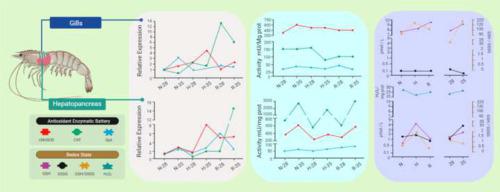Comparative Biochemistry and Physiology A: Molecular & Integrative Physiology ( IF 2.1 ) Pub Date : 2021-01-16 , DOI: 10.1016/j.cbpa.2021.110909 Paulina Estrada-Cárdenas 1 , Dalia G Cruz-Moreno 1 , Ricardo González-Ruiz 1 , Alma B Peregrino-Uriarte 1 , Lilia Leyva-Carrillo 1 , Laura Camacho-Jiménez 1 , Idania Quintero-Reyes 2 , Gloria Yepiz-Plascencia 1

|
Low oxygen concentration in water (hypoxia) and high temperature are becoming more frequent due to climate change, forcing animals to endure stress or decease. Hypoxia and high temperature stress can lead to reactive oxygen species (ROS) accumulation and oxidative damage to the organisms. The shrimp Litopenaeus vannamei is the most cultivated crustacean worldwide. The aim of this study was to evaluate the expression and enzymatic activity of glutathione peroxidase (GPx), catalase (CAT) and cytosolic manganese superoxide dismutase (cMnSOD) in gills and hepatopancreas from L. vannamei in response to two combined stressors: hypoxia and reoxygenation at control and high temperature (28 vs 35 °C, respectively). In addition, glutathione and hydrogen peroxide content were analyzed. The changes were mainly tissue-specific. In gills, cMnSOD expression and enzymatic activity increased in response to the interactions between oxygen variation and thermal stress, while GPx and CAT were maintained. More changes occurred in GPx, CAT and MnSOD in hepatopancreas than in gills, mainly due to the effect of the individual stress factors of thermal stress or oxygen variations. On the other hand, the redox state of glutathione indicated that during high temperature, changes in the GSH/GSSG ratio occurred due to the fluctuations of GSSG. Hydrogen peroxide concentration was not affected by thermal stress or oxygen variations in hepatopancreas, whereas in gills, it was not detected. Altogether, these results indicate a complex pattern of antioxidant response to hypoxia, reoxygenation, high temperature and their combinations.
中文翻译:

缺氧和高温共同影响南美白对虾抗氧化酶、谷胱甘肽和过氧化氢的反应
由于气候变化,水中的低氧浓度(缺氧)和高温变得更加频繁,迫使动物忍受压力或死亡。缺氧和高温胁迫会导致活性氧 (ROS) 积累和对生物体的氧化损伤。虾南美白对虾是最耕地甲壳全球。本研究的目的是评估谷胱甘肽过氧化物酶 (GPx)、过氧化氢酶 (CAT) 和胞质锰超氧化物歧化酶 (cMnSOD) 在南美白对虾鳃和肝胰腺中的表达和酶活性,以响应两种组合压力:缺氧和再氧合在控制和高温下(28 vs35°C,分别)。此外,还分析了谷胱甘肽和过氧化氢的含量。这些变化主要是组织特异性的。在鳃中,cMnSOD 表达和酶活性随着氧变化和热应激之间的相互作用而增加,而 GPx 和 CAT 保持不变。与鳃相比,肝胰腺中GPx、CAT和MnSOD的变化更多,主要是由于热应激或氧气变化等个体应激因素的影响。另一方面,谷胱甘肽的氧化还原状态表明,在高温期间,由于 GSSG 的波动,GSH/GSSG 比率发生了变化。过氧化氢浓度不受肝胰腺中热应激或氧气变化的影响,而在鳃中则未检测到。共,











































 京公网安备 11010802027423号
京公网安备 11010802027423号